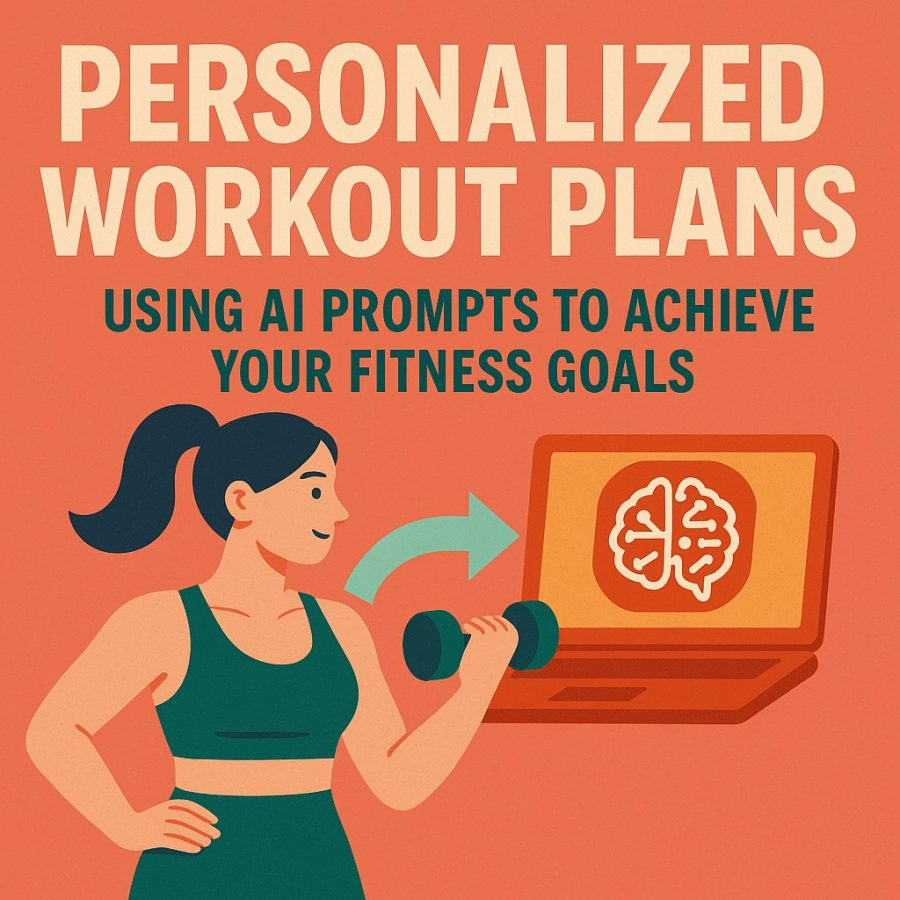Views: 0
Ever feel stuck cycling through the same cookie-cutter routines at the gym and never quite hitting your targets? You’re not alone. Generic plans can leave you bored, unmotivated, or worse injured.
That’s why personalized workout plans are the game changer. By tapping into AI’s power. You can create bespoke routines that align perfectly with your body, schedule, and fitness ambitions.
In this post, you’ll discover how using AI prompts to achieve your fitness goals makes customization easier than ever and why this approach will keep you excited about every sweat session.
Why Personalized Workout Plans Matter
Most off-the-shelf programs assume everyone has the same strengths, weaknesses, and time constraints and that’s a recipe for plateau city. When you tailor exercises to your current fitness level and personal objectives, each rep serves a purpose.
Whether you’re training for a 5K, building muscle mass, or improving flexibility, a custom routine ensures every movement counts toward your fitness goals.
Moreover, individualized plans help prevent injury by factoring in past ailments or mobility limitations. An AI-generated strategy can suggest alternatives such as swapping standard squats for box squats if you have knee issues so you stay on track without sidelining yourself.
Personalized guidance like this keeps you safe and motivated, setting the stage for sustainable progress.
Finally, bespoke workouts adapt as you evolve. Instead of sticking with the same weights or running mileage indefinitely, your plan can scale up or dial back based on real-time feedback.
This dynamic adjustment prevents burnout and fosters ongoing improvement, making your fitness journey both challenging and achievable.
How AI Prompts Transform Fitness Routines
Imagine having a virtual coach who listens to your preferences, remembers past sessions, and suggests fresh routines daily. By using AI prompts, you effectively “program” the assistant with your profile and objectives. The AI then combines exercise science best practices with your unique requirements, delivering a tailor-made workout in seconds.
Rather than manually piecing together exercises, rest intervals, and progression milestones, a well-crafted prompt instructs the AI to handle the heavy lifting. For instance, you might ask:
“Create a four-week strength plan for intermediate lifters focusing on upper-body hypertrophy, with three workouts per week and optional mobility drills.”
Tip: Copy and past this into ChatGPT with your numbers. Give it a try.
In return, the AI provides a structured schedule, exercise selections, and rep schemes no guesswork involved. This approach turns planning from a chore into a quick tap-and-go experience.
Because the AI draws from an extensive knowledge base, it can also weave in motivational cues, nutritional tips, and recovery advice. The result is a holistic, AI-powered fitness plan that feels like it was crafted by a seasoned personal trainer without the hourly rate.
Automatically apply coupons that have been proven to save!
My hosting was 79% off with Honey’s coupon for a while you are browsing and checking out, from desktop to tablet, to mobile, Honey delivers savings.
Honey is an extension and application that you download to your phone and Install the Chrome Extension. Once you choose what brands you want to be saving with (PRO TIP: Mark them all). Then you go about your normal browsing routine. When a product is viewed, Honey will compare all coupons to see what it can save you.

Getting Started: Define Your Fitness Goals
Before firing off AI prompts, get crystal clear on what you want to achieve. Ask yourself:
- What’s your primary objective? (e.
- g., weight loss, muscle gain, endurance)
- How much time can you commit? (minutes per session, days per week)
- Do you have any limitations? (previous injuries, equipment constraints)
Jot down these details so your AI assistant has a precise blueprint. For example:
“I want a beginner-friendly circuit plan to burn fat, using only dumbbells and bodyweight, 30 minutes per session, four times a week.”
Having a well-defined target helps the AI generate a customized workout routine that aligns with your lifestyle rather than forcing you to adapt to a one-size-fits-all regimen.
Crafting AI Workout Prompts That Work
The magic lies in clear, specific instructions. Follow these best practices when composing your prompts:
- State the Role:
Open with “Act as a certified fitness coach” to set the AI’s persona. - Define the Scope:
Specify timeframe (e.g., “8-week plan”), frequency (“five workouts per week”), and focus areas (“strength and cardio mix”). - Mention Constraints:
Note any equipment (“resistance bands only”), space (“home workouts”), or health considerations (“lower back pain”). - Include Progression:
Ask for gradual increases in intensity or volume, ensuring the plan evolves as you improve. - Request Formatting:
Indicate how you want the output tables, bullet lists, or weekly schedules for easy reference.
A sample play-by-play prompt might look like:
“Act as a certified fitness coach and draft an 8-week, four-day-per-week program for weight loss. Each session should be under 45 minutes, use only dumbbells and bodyweight, include warm-up and cooldown, and increase difficulty by week 4.”
With this level of clarity, your AI assistant can deliver a precise, goal-driven workout plan that feels hand-crafted.
Picking an AI Fitness Coach Tool
Not all AI interfaces are created equal. Here’s what to look for when choosing your virtual trainer:
- Custom Instructions Support:
Ensure the platform lets you feed detailed prompts and context so your assistant remembers your preferences. - Token or Usage Limits:
Check whether your prompt length or number of requests is capped, especially if you plan on frequent adjustments. - Integration Options:
Some AI tools connect with fitness apps (like Strava or Apple Health), automatically importing progress data to refine future plans. - User-Friendly Interface:
A clean, conversational dashboard makes it easier to tweak prompts and view your weekly schedule at a glance. - Community and Templates:
Platforms offering shared prompt libraries or community-created templates can save time and spark new ideas.
Whether you choose a chatbot-style UI or an AI fitness app, pick one that meshes with your workflow, so you stay consistent with updates and adjustments over time.
Sample AI Prompts for Customized Workout Routines
Use these starter prompts to unlock powerful, AI-driven fitness plans:
- Full-Body Beginner Boost
“You’re a personal trainer. Create a 6-week, three-day-per-week full-body routine for a complete beginner. Include warm-up, three main exercises, and cooldown, all under 40 minutes.” - Equipment-Free Cardio Circuit
“Act as a fitness coach. Draft a four-week treadmill-free cardio plan with HIIT and steady-state days, 30 minutes each, including incline runs and bodyweight sprints.” - Upper/Lower Split for Muscle Gain
“Design an 8-week upper/lower split for intermediate lifters aiming to gain muscle. List exercises, sets, reps, and rest times for each workout.” - Mobility and Strength Fusion
“Generate a hybrid 5-day program combining yoga-based mobility flows with strength training. Each session should balance flexibility and compound lifts.” - Weekend Warrior Plan
“Create a two-day intensive weekend routine for busy professionals with only kettlebells. Focus on full-body strength and core stability.”
Feel free to tweak these prompts swap equipment, adjust time frames, or add nutrition notes to make the plan truly yours.
Tips for Maximizing Your AI-Generated Fitness Plan
- Log Your Workouts:
Track reps, weights, and how you feel. Feeding this data back into your prompts helps the AI fine-tune future sessions. - Stay Flexible:
Life happens. Ask the AI to modify sessions when you’re short on time or need extra recovery. - Mix and Match Plans:
Combine elements from different AI-generated routines to keep things fresh and prevent plateaus. - Consult Experts if Needed:
While AI is powerful, always check with a medical professional or certified trainer if you have serious health concerns. - Celebrate Milestones:
Set checkpoints every 2–4 weeks and let the AI suggest celebratory deload weeks or active recovery sessions.
Conclusion
Gone are the days of one-size-fits-all fitness programs that leave you guessing and bored. By embracing personalized workout plans powered by AI prompts, you gain a dynamic, scalable, and engaging path to achieve your fitness goals. Start by defining your objectives, crafting clear prompts, and selecting the right AI tool. Then experiment with sample commands and fine-tune based on your progress. With this approach, every sweat session becomes a step closer to the stronger, healthier you. Ready to revolutionize your workouts? Fire up your AI assistant and watch your fitness journey transform one custom plan at a time.


